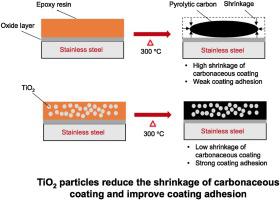当前位置:
X-MOL 学术
›
Prog. Org. Coat.
›
论文详情
Our official English website, www.x-mol.net, welcomes your feedback! (Note: you will need to create a separate account there.)
Carbon-containing-titania coated stainless steel prepared by high voltage powder spray coating and its adhesion phenomena
Progress in Organic Coatings ( IF 6.6 ) Pub Date : 2020-10-01 , DOI: 10.1016/j.porgcoat.2020.105782 Farah Syuhada Abdul Halim , Sheela Chandren , Hadi Nur
Progress in Organic Coatings ( IF 6.6 ) Pub Date : 2020-10-01 , DOI: 10.1016/j.porgcoat.2020.105782 Farah Syuhada Abdul Halim , Sheela Chandren , Hadi Nur

|
Abstract Nowadays, many studies involve coating materials on stainless steel prepared by various methods, and many approaches have been taken to improve the abrasion resistance of the coatings. Here, the attachment of carbon/titania (C/TiO2) on stainless steel and the evaluation of its coating adhesion is reported. The commercially available epoxy resin was used as the source of carbon, and the transformation from epoxy resin to pyrolytic carbon was performed. It is proposed that the incorporation of an inorganic particle will improve the adhesion properties through the reduction of the carbon shrinkage. C/TiO2 was prepared from the mixture of commercialized epoxy resin (Oxyplast PR12®) and anatase TiO2 powder, followed by spraying the mixture onto stainless steel (AISI 304) surface using high voltage powder spray coating (HVPSC). The sprayed powders on stainless steel underwent pyrolysis at several temperatures from 300 to 700 °C for an hour to determine the optimum temperature for excellent adhesion. The physical properties of C/TiO2 coated samples were characterized by Fourier transform infrared (FTIR) spectroscopy, field emission scanning electron microscopy (FESEM), surface profiler meter and X-ray photoelectron (XPS) spectroscopy. The FTIR analysis of C/TiO2 coating identified the appearance of peaks C H sp3, C O, C O, and Ti O. It was noticed that the absorption band of C H sp3, C O, and C O slowly disappeared as the pyrolysis temperature increased, indicating that the structure changed from epoxide to pyrolytic carbon. FESEM images showed that the TiO2 particles were fully covered with the carbon layer, and the thickness was determined to be in the range of 4.8–15.5 μm. The abrasive and peel adhesion test was performed, showing no detachment of coated material of C/TiO2 pyrolyzed at 300 °C, suggesting that this temperature produces the best coating adhesion. The carbon-based coating adhesion phenomena were elucidated by XPS analysis of Fe2p, C1s, and Ti2p element peaks. It was demonstrated that the presence of an oxide layer on stainless steel, availability of functional groups, and structure shrinkage were the factors that affect the adhesion of the carbonaceous coating. The structure shrinkage was reduced due to the presence of TiO2, which is associated with strong coating adhesion. This demonstrated that the carbonaceous coating produced by HVPSC formed an excellent adhesion in the presence of TiO2.
中文翻译:

高压粉末喷涂制备含碳二氧化钛涂层不锈钢及其粘附现象
摘要 目前,许多研究涉及通过各种方法制备的不锈钢涂层材料,并采取了许多方法来提高涂层的耐磨性。在这里,报告了碳/二氧化钛 (C/TiO2) 在不锈钢上的附着及其涂层附着力的评估。以市售环氧树脂为碳源,进行环氧树脂向热解碳的转化。建议掺入无机颗粒将通过减少碳收缩来提高粘附性能。C/TiO2 由商业化环氧树脂 (Oxyplast PR12®) 和锐钛矿 TiO2 粉末的混合物制备,然后使用高压粉末喷涂 (HVPSC) 将混合物喷涂到不锈钢 (AISI 304) 表面上。喷涂在不锈钢上的粉末在 300 至 700 °C 的几个温度下热解一小时,以确定实现优异附着力的最佳温度。通过傅里叶变换红外 (FTIR) 光谱、场发射扫描电子显微镜 (FESEM)、表面轮廓仪和 X 射线光电子 (XPS) 光谱表征 C/TiO2 涂层样品的物理性质。C/TiO2 涂层的 FTIR 分析确定了 CH sp3、CO、CO 和 Ti O 峰的出现。注意到 CH sp3、CO 和 CO 的吸收带随着热解温度的升高慢慢消失,表明结构从环氧化物变为热解碳。FESEM 图像显示 TiO2 颗粒被碳层完全覆盖,厚度确定在 4.8-15 的范围内。5微米。进行了磨料和剥离附着力测试,显示在 300°C 热解的 C/TiO2 涂层材料没有分离,表明该温度产生了最好的涂层附着力。通过 Fe2p、C1s 和 Ti2p 元素峰的 XPS 分析阐明了碳基涂层粘附现象。结果表明,不锈钢上氧化层的存在、官能团的可用性和结构收缩是影响碳质涂层附着力的因素。由于 TiO2 的存在,结构收缩减少,这与强大的涂层附着力有关。这表明HVPSC 产生的碳质涂层在TiO2 存在下形成了极好的附着力。显示在 300 °C 下热解的 C/TiO2 涂层材料没有分离,表明该温度产生最佳涂层附着力。通过 Fe2p、C1s 和 Ti2p 元素峰的 XPS 分析阐明了碳基涂层粘附现象。结果表明,不锈钢上氧化层的存在、官能团的可用性和结构收缩是影响碳质涂层附着力的因素。由于 TiO2 的存在,结构收缩减少,这与强大的涂层附着力有关。这表明HVPSC 产生的碳质涂层在TiO2 存在下形成了极好的附着力。显示在 300 °C 下热解的 C/TiO2 涂层材料没有分离,表明该温度产生最佳涂层附着力。通过 Fe2p、C1s 和 Ti2p 元素峰的 XPS 分析阐明了碳基涂层粘附现象。结果表明,不锈钢上氧化层的存在、官能团的可用性和结构收缩是影响碳质涂层附着力的因素。由于 TiO2 的存在,结构收缩减少,这与强大的涂层附着力有关。这表明HVPSC 产生的碳质涂层在TiO2 存在下形成了极好的附着力。通过 Fe2p、C1s 和 Ti2p 元素峰的 XPS 分析阐明了碳基涂层粘附现象。结果表明,不锈钢上氧化层的存在、官能团的可用性和结构收缩是影响碳质涂层附着力的因素。由于 TiO2 的存在,结构收缩减少,这与强大的涂层附着力有关。这表明HVPSC 产生的碳质涂层在TiO2 存在下形成了极好的附着力。通过对 Fe2p、C1s 和 Ti2p 元素峰的 XPS 分析阐明了碳基涂层粘附现象。结果表明,不锈钢上氧化层的存在、官能团的可用性和结构收缩是影响碳质涂层附着力的因素。由于 TiO2 的存在,结构收缩减少,这与强大的涂层附着力有关。这表明HVPSC 产生的碳质涂层在TiO2 存在下形成了极好的附着力。由于 TiO2 的存在,结构收缩减少,这与强大的涂层附着力有关。这表明HVPSC 产生的碳质涂层在TiO2 存在下形成了极好的附着力。由于 TiO2 的存在,结构收缩减少,这与强大的涂层附着力有关。这表明HVPSC 产生的碳质涂层在TiO2 存在下形成了极好的附着力。
更新日期:2020-10-01
中文翻译:

高压粉末喷涂制备含碳二氧化钛涂层不锈钢及其粘附现象
摘要 目前,许多研究涉及通过各种方法制备的不锈钢涂层材料,并采取了许多方法来提高涂层的耐磨性。在这里,报告了碳/二氧化钛 (C/TiO2) 在不锈钢上的附着及其涂层附着力的评估。以市售环氧树脂为碳源,进行环氧树脂向热解碳的转化。建议掺入无机颗粒将通过减少碳收缩来提高粘附性能。C/TiO2 由商业化环氧树脂 (Oxyplast PR12®) 和锐钛矿 TiO2 粉末的混合物制备,然后使用高压粉末喷涂 (HVPSC) 将混合物喷涂到不锈钢 (AISI 304) 表面上。喷涂在不锈钢上的粉末在 300 至 700 °C 的几个温度下热解一小时,以确定实现优异附着力的最佳温度。通过傅里叶变换红外 (FTIR) 光谱、场发射扫描电子显微镜 (FESEM)、表面轮廓仪和 X 射线光电子 (XPS) 光谱表征 C/TiO2 涂层样品的物理性质。C/TiO2 涂层的 FTIR 分析确定了 CH sp3、CO、CO 和 Ti O 峰的出现。注意到 CH sp3、CO 和 CO 的吸收带随着热解温度的升高慢慢消失,表明结构从环氧化物变为热解碳。FESEM 图像显示 TiO2 颗粒被碳层完全覆盖,厚度确定在 4.8-15 的范围内。5微米。进行了磨料和剥离附着力测试,显示在 300°C 热解的 C/TiO2 涂层材料没有分离,表明该温度产生了最好的涂层附着力。通过 Fe2p、C1s 和 Ti2p 元素峰的 XPS 分析阐明了碳基涂层粘附现象。结果表明,不锈钢上氧化层的存在、官能团的可用性和结构收缩是影响碳质涂层附着力的因素。由于 TiO2 的存在,结构收缩减少,这与强大的涂层附着力有关。这表明HVPSC 产生的碳质涂层在TiO2 存在下形成了极好的附着力。显示在 300 °C 下热解的 C/TiO2 涂层材料没有分离,表明该温度产生最佳涂层附着力。通过 Fe2p、C1s 和 Ti2p 元素峰的 XPS 分析阐明了碳基涂层粘附现象。结果表明,不锈钢上氧化层的存在、官能团的可用性和结构收缩是影响碳质涂层附着力的因素。由于 TiO2 的存在,结构收缩减少,这与强大的涂层附着力有关。这表明HVPSC 产生的碳质涂层在TiO2 存在下形成了极好的附着力。显示在 300 °C 下热解的 C/TiO2 涂层材料没有分离,表明该温度产生最佳涂层附着力。通过 Fe2p、C1s 和 Ti2p 元素峰的 XPS 分析阐明了碳基涂层粘附现象。结果表明,不锈钢上氧化层的存在、官能团的可用性和结构收缩是影响碳质涂层附着力的因素。由于 TiO2 的存在,结构收缩减少,这与强大的涂层附着力有关。这表明HVPSC 产生的碳质涂层在TiO2 存在下形成了极好的附着力。通过 Fe2p、C1s 和 Ti2p 元素峰的 XPS 分析阐明了碳基涂层粘附现象。结果表明,不锈钢上氧化层的存在、官能团的可用性和结构收缩是影响碳质涂层附着力的因素。由于 TiO2 的存在,结构收缩减少,这与强大的涂层附着力有关。这表明HVPSC 产生的碳质涂层在TiO2 存在下形成了极好的附着力。通过对 Fe2p、C1s 和 Ti2p 元素峰的 XPS 分析阐明了碳基涂层粘附现象。结果表明,不锈钢上氧化层的存在、官能团的可用性和结构收缩是影响碳质涂层附着力的因素。由于 TiO2 的存在,结构收缩减少,这与强大的涂层附着力有关。这表明HVPSC 产生的碳质涂层在TiO2 存在下形成了极好的附着力。由于 TiO2 的存在,结构收缩减少,这与强大的涂层附着力有关。这表明HVPSC 产生的碳质涂层在TiO2 存在下形成了极好的附着力。由于 TiO2 的存在,结构收缩减少,这与强大的涂层附着力有关。这表明HVPSC 产生的碳质涂层在TiO2 存在下形成了极好的附着力。


























 京公网安备 11010802027423号
京公网安备 11010802027423号